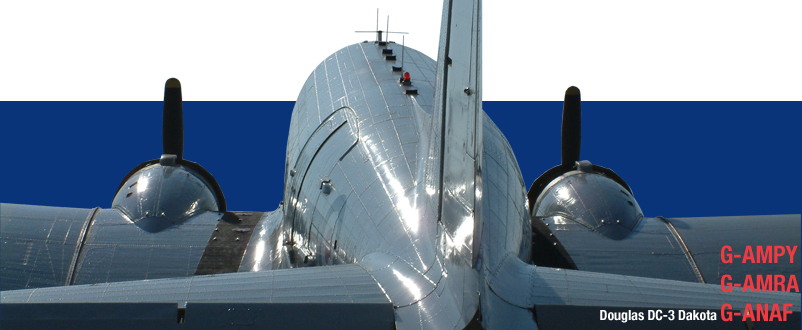
G-AMSV Returns to Coventry
An old friend returned to Coventry yesterday when G-AMSV, in her striking Indian Air force livery, landed here for extensive maintenance by our engineers. Sierra Victor was part of the Air Altantique fleet here for many years. She'll...
Baginton Air Pageant
The initial details for the Baginton Air Pageant are up on the website! As we don't have the space for a full-on air show attracting 20,000 or so people, we're aiming for low-key, themed days like this. A couple of thousand people,...
Newquay Pleasure flights
We promised we'd be back to fly in Cornwall, and here we are. We'll be heading south with a Rapide and Chipmunk to spend a week at Newquay from 25th July, with a further visit planned in August. The flights are bookable in the normal...
New Dakota Book
Geoff Jones just told me that his new book on the DC-3, released to celebrate the 80th anniversary of the Dak's appearance, is now available. The cover sports a lovely shot of G-ANAF, shot by Simon Westwood before her radome goiter was...
Nimrod Engine Run
We've just confirmed plans by NPT to run all four of the Nimrod's Rolls-Royce Speys on Saturday 9th May. We expect the thunder to start just after lunchtime. Come along and enjoy some audio power - and please dip into your pockets...


Looking at the sleek, surprisingly modern shape of the Dakota, it's hard to conceive that this iconic aircraft first flew on December 17, 1935. That makes it a contemporary of the Dragon Rapide, showing the diverging directions taken by between-war designers each side of the Atlantic. Britain needed light, short-range aircraft, capable of handling the limited facilities and rough,short airstrips of its widely-scattered empire. America, by contrast, had a requirement for larger, long-range machines to ply across its vast continent.
Like many of Man's most significant creations, the DC-3 was born out of a dispute. Transcontinental and Western Airlines (later known as TWA) needed an aircraft to allow them to compete with their rival, United Airlines. UA had ordered sixty of the Boeing 247, and Boeing declined to sell any to other airlines until their existing contract had been fulfilled. Douglas responded to the requirement with the promising DC-1 and more satisfactory DC-2.
It was strong persuasion from American Airlines that gave rise to a new Douglas airliner, which became the DC-3. AA needed a sleeper aircraft to replace their dated Curtiss Condor biplanes. Initially called theDST (Douglas Sleeper Transport), a non-sleeper version was quickly developed. With the sleeping berths removed, the new aircraft could accommodate 21 passengers.
The DC-3 had arrived.
A military version quickly followed, dubbed the C-47 Skytrain. Over 10,000 of these were manufactured, and they were responsible for delivery of the largest portion of invading airborne troops around D-Day. The Classic Air Force Dakotas are all actually C-47s.
The name Dakota was coined when the DC-3 joined the RAF. American aircraft were rarely named other than by their model letters, so familiar names like Mustang and Lightning were widely invented by transatlantic users. Dakota is said to come from Douglas Aircraft Company Transport Aircraft. It was widely known in its native America as the Gooney Bird.
The Dakota has remained in active service ever since. It has carried countless passengers and thousands of tons of freight to every part of the world, safely, reliably and in a style that is truly unique.
As the popular saying goes, "The only replacement for a DC-3 is another DC-3".

